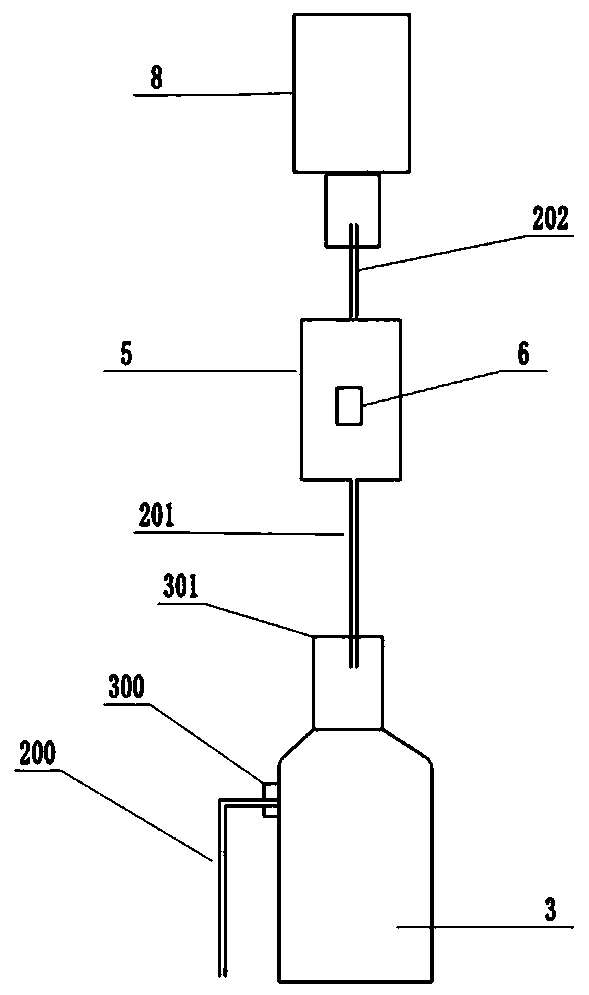Decellularization method for tissue engineering scaffold
A decellularization and cell technology, applied in the field of decellularization of biological materials, can solve the problems of complicated processing, damage, unsatisfactory mechanical strength or biological activity, etc.
- Summary
- Abstract
- Description
- Claims
- Application Information
AI Technical Summary
Problems solved by technology
Method used
Image
Examples
Embodiment 1
[0127] like figure 1 As shown, the decellularization device includes a first pipeline 200, a first container 3, a second pipeline 201, a second container 5, a third pipeline 202, and a third container 8 connected to the third pipeline 202, which are sequentially sealed and communicated; One end of the first pipeline 200 is connected to the first opening 300 of the first container 3; one end of the second pipeline 201 is connected to the second opening 301 of the first container 3; the other end of the second pipeline 201 is connected to the third pipeline One end of 202 is respectively connected to the two ends of the second container 5; the second container 5 is used to place the biological material 6, and the biological material 6 cannot enter the second pipeline 201 and the third pipeline 202, and the solution includes cells It can enter the second pipeline 201 and the third pipeline 202 . The position of the third container 8 is higher than that of the second container 5,...
Embodiment 2
[0129] Another embodiment of the present invention, such as figure 2 As shown, the decellularization device also includes a negative pressure suction device 1, the negative pressure suction device 1 can be a circulating water vacuum pump with a power switch 100 and a vacuum port 101 on it. There are three openings on the first container 3 , which are the first opening 300 and the second opening 301 , wherein the first opening 300 is connected to the vacuum interface 101 on the negative pressure suction device 1 through the first pipeline 200 . The decellularization device may also include a glass tube 4 , one end of the glass tube 4 is inserted into the first container 3 through the second opening 301 on the first container 3 ; the other end is connected to one end of the second pipeline 201 . In this embodiment, the second opening 301 on the first container 3 can be plugged with a rubber stopper, and the glass tube 4 can be inserted into the third container 3 through the rub...
Embodiment 3
[0138] In one of the embodiments of the present invention, in embodiment 1 figure 2 On the basis of the decellularization device, the decellularization liquid (used decellularization liquid) in the first container 3 can be recycled. like Figure 4 As shown, there is used decellularization liquid (waste liquid) in the first container 3, and one end of the glass tube 4 is inserted below the liquid level of the waste liquid (wherein the first container 3 is ventilated, for example, the rubber stopper can be removed).
[0139] The third container 8 is replaced by a fourth container 11 . The fourth container 11 has an opening 110 , an opening 111 and an opening 112 , and the opening 110 is connected to the vacuum interface 101 on the negative pressure suction device 1 through the first pipeline 200 .
[0140] When the decellularization device starts to work, the first opening 300 and the third opening 302 on the first container 3 are closed. When the negative pressure suction d...
PUM
 Login to View More
Login to View More Abstract
Description
Claims
Application Information
 Login to View More
Login to View More - R&D
- Intellectual Property
- Life Sciences
- Materials
- Tech Scout
- Unparalleled Data Quality
- Higher Quality Content
- 60% Fewer Hallucinations
Browse by: Latest US Patents, China's latest patents, Technical Efficacy Thesaurus, Application Domain, Technology Topic, Popular Technical Reports.
© 2025 PatSnap. All rights reserved.Legal|Privacy policy|Modern Slavery Act Transparency Statement|Sitemap|About US| Contact US: help@patsnap.com



